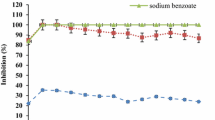Abstract
Essential oil of aerial parts of Warionia saharae was obtained by hydrodistillation and analyzed by GC and GC-MS. Thirty-nine compounds were identified, accounting for 93.2% of the total oil. β-Eudesmol (34.9%), nerolidol-E (23%), and linalool (15.2%) were the most abundant components. The antifungal activity of the W. saharae oil was tested by poisoned food (PF) technique and the volatile activity (VA) assay against 3 phytopathogenic causing the deterioration for apple. The results indicated that the W. saharae oil inhibited significantly the mycelial growth of all strains tested (p<0.05). The minimum inhibitory concentration against Alternaria sp. was 2 μL/mL air in VA assay, whereas >2 μL/mL in PF technique for all strains. Fungal spore production was completely inhibited at 1 μL/mL air for Alternaria sp. and at 2 μL/mL air for Penicillium expansum and Rhizopus stolonifer.
Similar content being viewed by others
References
Nanasombat S, Wimuttigosol P. Antimicrobial and antioxidant activity of spice essential oils. Food Sci. Biotechnol. 20: 45–53 (2011)
Znini M, Cristofari G, Majidi L, Mazouz H, Tomi P, Paolini J, Costa J. Antifungal activity of essential oil from Asteriscus graveolens against postharvest phytopathogenic fungi in apples. Nat. Prod. Commun. 6: 1763–1768 (2011)
Gumus T, Demirci AS, Sagdic O, Arici M. Inhibition of heat resistant molds: Aspergillus fumigatus and Paecilomyces variotii by some plant essential oils. Food Sci. Biotechnol. 19: 1241–1244 (2010)
Bentham G. Notes on the classification, history, and geographical distribution of Compositae. J. Linn. Soc. (London Bot.) 13: 335–577 (1873)
Gómez F. Flora Selecta Marroquí (Flora Moroccan Elite). Francisco José Nevero Díezed. España (2001)
Watillon C, Gaspar T, Hofinger M, Ramaut JL. Microprogagation of Warionia saharae Benth. & Coss. Al Biruniya 4: 35–38 (1987)
Bellakhdar J, Baayaoui A, Kazdari A, Marechal J. Herbalist and folk medicine at Tissint a presaharian oasis of the Moroccan south. Al Biruniya 3: 7–50 (1986)
Hilmi F. Cytotoxic and anti-inflamatory sesquiterpene lactones from Warionia saharae. A traditional remedy from Morocco. PhD thesis, Swiss Federal Institute of Technology Zurich, Switzerland (2002)
European Pharmacopoeia. Council of Europe. 3rd ed. Strasbourg, France. pp. 121–122 (1997)
Dool H, Kratz P. A generalization of the retention index including linear temperature programmed gas liquid partition chromatography. J. Chromatogr. 11: 463–471 (1963)
Joulain D, König WA. The Atlas of Spectral Data of Sesquiterpene Hydrocarbons. EbVerlag, Hamburg, Germany. pp. (1998)
Hochmuth D, Joulain D, König WA. Terpenoids and Related Constituents of Essential Oils. Library of Massfinder 2. 1 University of Hamburg Institute of Organic Chemistry, Hamburg, Germany. pp. (2001)
Adams RP. Identification of essential oil components by gas chromatography/quadrupole mass spectroscopy. Allured Publishing Corporation, Carol Stream, IL, USA (2004)
Costa R, Zellner BA, Crupi, ML, De Fina MR, Valentino MR, Dugo P, Dugo G. GC-MS, GC-O, and enantio-GC investigation of the essential oil of Tarchonanthus camphoratus L. Flavour Frag. J. 23: 40–48 (2008)
Barnett HL, Hunter BB. Illustrated Genera of Imperfect Fungi. 3rd ed. Burgess Publishing Company, Minneapolis, MN, USA. p. 241 (1972)
Rhayour K, Bouchikhi T, Tantaoui-Elaraki A, Sendide K, Remmal A. The mechanism of bactericidal action of oregano and clove essential oils and their phenolic major components on Escherichia coli and Bacillus subtilis. J. Essent. Oil Res. 15: 286–292 (2003)
Soylu EM, Kurt S, Soylu S. In vitro and in vivo antifungal activities of the essential oils of various plants against tomato grey mould disease agent Botrytis cinerea. Int. J. Food Microbiol. 143: 183–189 (2010)
Pandey DK, Tripathi NN, Tripathi RD, Dixit SN. Fungitoxic and phytotoxic properties of the essential oil of H. suaveolens. Z. Panzenk. Panzen. 89: 344–349 (1982)
Tzortzakis NG, Economakis CD. Antifungal activity of lemongrass (Cympopogon citratus L.) essential oil against key postharvest pathogens. Innov. Food Sci. Emerg. 8: 253–258 (2007)
Ramaut JL, Hofimger M, Dimbi R, Corvisier M, Lewalle J. Main constituents of the essential oil of Warionia saharae Benth & Coss. Chromatographia 20: 193–194 (1985)
Essaqui A, Elamrani A, Cayuela JA, Benaissa M. Chemical composition of the essential oil of Warionia saharae from Morocco. J. Essent. Oil Bear. Pl. 10: 241–246 (2007)
Mori M, Aoyama M, Doi S. Antifungal constituents in the bark of Magnolia obovata Thunb. Eur. J. Wood Prod. 55: 275–278 (1997)
Itoh K, Ogawa T, Tachibana S, Kusuma IW. Isolation and identification of an antifungal sesquiterpene alcohol from amboyna wood. Pak. J. Biol. Sci. 7: 1735–1740 (2004)
Ijaz-Hussain A, Farooq A, Hussain-Sherazi ST, Przybylski R. Chemical composition, antioxidant, and antimicrobial activities of basil (Ocimum basilicum) essential oils depends on seasonal variations. Food Chem. 108: 986–995 (2008)
Park MJ, Gwak KS, Yang I, Kim KW, Jeung EB, Chang JW, Choi IG. Effect of citral, eugenol, nerolidol, and α-terpineol on the ultrastructural changes of Trichophyton mentagrophytes. Fitoterapia 80: 290–296 (2009)
Survilienė E, Valiuškaitė A, Snieškienė V, Stankevičienė A. Effect of essential oils on fungi isolated from apples and vegetables. Scientific Works Of The Lithuanian Institute Of Horticulture And Lithuanian, University Of Agriculture, Sodininkyst Ir Darininkyst, 28: 227–234 (2009)
Sharma N, Tripathi A. Fungitoxicity of the essential oil of Citrus sinensis on post-harvest pathogen. World J. Microbiol. Biot. 22: 587–593 (2006)
Inouye S, Tsuruoka T, Watanabe M, Takeo K, Akao M, Nishiyama Y, Yamaguchi H. Inhibitory effect of essential oils on apical growth of Aspergillus fumigatus by vapor contact. Mycoses 43: 17–23 (2000)
Edris AE, Farrag ES. Antifungal activity of peppermint and sweet basil essential oils and their major aroma constituents on some plant pathogenic fungi from the vapor phase. Nahrung/Food 47: 117–121 (2003)
Tataoui-Elaraki A, Ferhout H, Errifi A. Inhibition of the fungal asexual reproduction stages by three Moroccan essential oils. J. Essent. Oil Res. 5: 535–545 (1993)
Author information
Authors and Affiliations
Corresponding author
Rights and permissions
About this article
Cite this article
Znini, M., Cristofari, G., Majidi, L. et al. In vitro antifungal activity and chemical composition of Warionia saharae essential oil against 3 apple phytopathogenic fungi. Food Sci Biotechnol 22 (Suppl 1), 113–119 (2013). https://doi.org/10.1007/s10068-013-0056-2
Received:
Revised:
Accepted:
Published:
Issue Date:
DOI: https://doi.org/10.1007/s10068-013-0056-2




